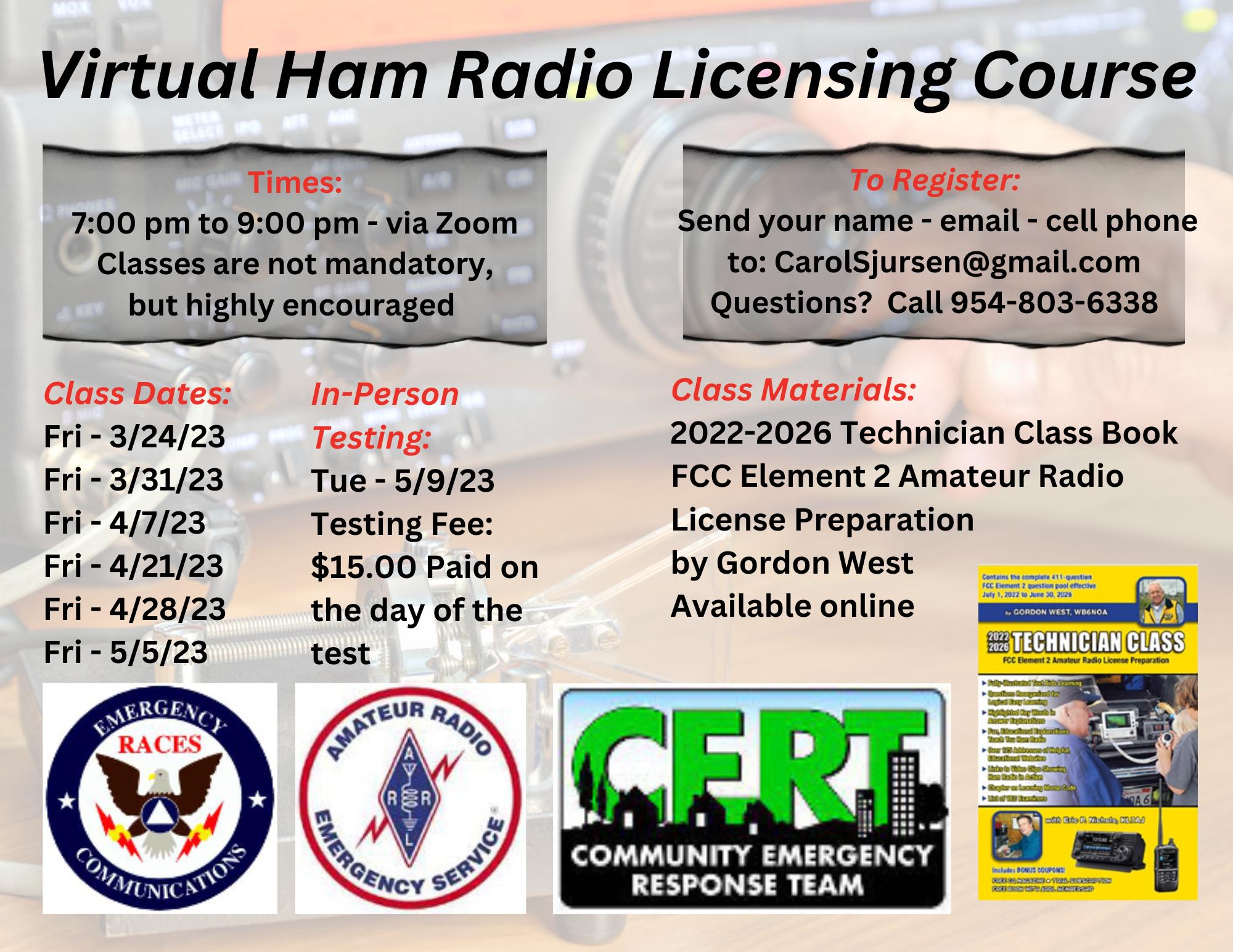The Benefits of Getting a Ham Radio License
by siteadmin

Ham radio is a fascinating hobby that has been around since 1912. Its use is still common, and it is a great way to stay connected with friends and family.
Getting your ham radio license is simple. You can study online or in a book, but it is often helpful to attend a class or a lecture to learn more about the subject.
Why Get a Ham Radio License?
Ham radio, also known as amateur radio, is one of the most popular ways to communicate without using cellular or internet services. Whether you are traveling abroad, looking for an alternative to WiFi hotspots, or simply want to stay connected with family and friends around the country, amateur radio is a great way to get in touch.
It’s an incredibly social hobby that can bring you in contact with new people all over the world. You’ll find meet-up groups and social events in your area, and there are even online communities that buzz with activity.
Besides casual communication, amateur radio is also used to communicate during disasters and emergencies. For example, during Hurricane Katrina, ham operators stayed on the air and assisted emergency crews with communications.
Amateur radio is regulated by the FCC, and it’s important to get a license if you plan on using your amateur radio for anything other than casual conversation. A ham radio license proves you have the knowledge and experience to operate this equipment legally, which is critical in many situations.
The most basic ham radio license is the Technician class, which gives you access to VHF and UHF frequencies. However, there are several other license classes as well. The General and Extra classes are higher-level and offer more privileges, such as HF frequencies.
If you have never owned a radio before, or are a beginner, consider joining your local ham radio club for free lessons and training. This will help you gain the confidence and skills you need to pass your ham radio license exam.
You can also find a study guide online or at your local library, or purchase an inexpensive study book to help you prepare for the exam. Regardless of how you choose to learn, it’s best to have a regular study schedule and to write down what you’re learning so that you can remember it later.
The ham radio license process can be a little daunting at first, but it’s not as difficult as it seems. With a little planning and dedication, you can get your ham radio license in no time at all.
How to Get a Ham Radio License
Getting your ham radio license is an important step to becoming part of the worldwide amateur radio community. It will help you connect with fellow hams and share experiences as you learn new skills. It is also a vital tool in emergency communication.
In the US, the Federal Communications Commission (FCC) requires anyone who wants to use their radio for personal use to get a license. The license entitles you to access the many frequencies available to ham radio operators, including shortwave radio.
There are three license classes: Technician, General, and Amateur Extra. Generally, the higher the class you obtain, the more frequency privileges you’ll be granted.
If you’re a beginner, the Technician class is recommended. This is because it grants access to all the ham radio frequencies that are above 30 megahertz. This allows you to communicate locally within your city or town, but not as far away as with a General or Amateur Extra license.
The ham radio industry is still growing in the United States and around the world. The hobby is an excellent way to learn about electronics and technology, and it can be fun for the whole family.
To get your ham radio license, you can take a test at your local ham club or take it online using an FCC-approved testing site. You can also contact the American Radio Relay League (ARRL) for a list of available tests in your area.
Once you’ve passed the exam, you can then submit your application to the FCC. This process can take several weeks, so you’ll want to plan your study time accordingly. The FCC will issue your license once you pass the test, but you must pay a $35 fee to the ARRL and a $15 fee for each exam attempt.
Getting your license can be an exciting and rewarding experience, so don’t miss out! You’ll also have a great time connecting with other amateur radio enthusiasts worldwide.
Before you begin studying for the ham radio license exam, make sure to research and prepare for it thoroughly. It can be difficult to pass the exam if you don’t have a strong understanding of the subject. If you’re unsure of where to start, don’t hesitate to seek advice from experts and experienced hams. You can also use a study guide to help you understand the material better.
Cost of Getting a Ham Radio License
Ham radio is an exciting hobby that allows people to communicate over the airwaves. It has a wide range of benefits, including the chance to meet new friends, travel around the world, and learn about other cultures.
The cost of getting a ham radio license depends on the type of license you need, as well as where you live. In some countries, the costs are extremely low, while in others, they can be very high.
If you want to get a general license, you will need to pay a fee of $35 to the Federal Communications Commission (FCC). This does not include the $15 exam fee that the American Radio Relay League (ARRL) usually charges.
You will also need to buy a ham radio, which can be as cheap as $100 for a handheld model or as expensive as $500 for an advanced transceiver. Choosing the right radio is crucial, as it will determine how effective your ham radio is and whether you can connect with other people across the globe.
Another essential ham radio accessory is an antenna, which can be as inexpensive as $25 for a simple roof-mount antenna or as costly as tens of thousands of dollars for a tower or yagi antenna. While this is not necessary for casual hams, it is important if you are planning to use your radio to transmit over a wider area.
Having access to multiple amateur radio bands is especially beneficial for emergency communication during natural disasters such as hurricanes and tornadoes. The ability to communicate with stations in other parts of the country or world via Winlink is also a valuable asset.
A technician class ham radio license is the most basic license and gives you the opportunity to communicate on all amateur radio frequencies above 30 megahertz. Once you pass this exam, you can advance to the general class license, which provides you with full privileges on most of the amateur radio frequencies.
If you want to upgrade your ham radio license, you should be prepared for the General exam, which is more difficult and requires a higher level of skill and knowledge. Taking this exam is one of the best ways to become an expert on ham radio, as it will test your knowledge of the basics and help you develop an understanding of the different frequencies that are available for amateur radio communication.
Benefits of Getting a Ham Radio License
The benefits of getting a ham radio license are many and varied. It’s a great way to learn new skills, meet people, and make friends from around the world. It’s also an essential tool in emergencies and disasters.
Using a ham radio is an excellent way to stay in touch with family and friends, even when you’re off the grid or without the ability to use a cell phone. During emergencies, a ham radio can help you contact people in a time of need and provide crucial communication links to first responders.
Another benefit of a ham radio license is that you can become part of an emergency preparedness team called CERT. This program was created by FEMA to encourage the public to get a ham radio license and become trained in emergency communications.
One of the most important aspects of a ham radio license is that it allows you to communicate with others during emergencies and disasters, such as tornadoes or hurricanes. These radios can be used to contact rescue teams, send out emergency messages, and even call for medical assistance if necessary.
Ham radio is also a fantastic hobby that’s fun for the whole family. You can learn new skills, meet new friends, and even compete in amateur radio competitions.
If you’re an outdoorsman or hiker, a ham radio license can be a lifesaver in a pinch. It’s easy to setup and use, and it can provide long-range communications if the internet or cellular networks are down.
In addition to providing vital communications during emergencies, ham radio can be used for technological advancement and scientific research. For example, Nobel Prize Winning astrophysicist Joe Taylor, K1JT, uses his ham radio knowledge to measure the distance between stars.
Scientists are also using ham radio to telemeter cubesats – miniature satellites used for research and exploration. The Japanese Aerospace Exploration Agency recently launched a series of cubesats that can send telemetry back to Earth via ham radio.
While ham radio may feel outdated in the age of cell phones and the internet, it is still an invaluable resource for many people. It gives you control over your own communication, and it’s a fantastic way to build self-reliance.
Ham radio is a fascinating hobby that has been around since 1912. Its use is still common, and it is a great way to stay connected with friends and family. Getting your ham radio license is simple. You can study online or in a book, but it is often helpful to attend a class or…
Recent Posts
- Lawn Care Spring Branch Advocates for Property Care: Combatting Weed Growth and Preserving Curb Appeal
- Expert Cleaners Lexington Shares Essential Tips for Properly Cleaning Hardwood Floors
- Expert Cleaners Lexington Shares Essential Tips for Properly Cleaning Hardwood Floors
- Delo Roofing: A Name You Can Trust for Exceptional Roofing Services
- Delo Roofing: A Name You Can Trust for Exceptional Roofing Services
